The Beaumaris Bushfires of 1944
The summer holidays of 1943/4 came at a time when Australia had already endured four years of war and had committed many thousands of men and women to the fight against the Axis powers overseas. Many more service personnel had been deployed in far-flung locations within Australia. In the Melbourne bayside suburbs, as in all parts of Australia, austerity measures were in place with rationing of basic goods, and a labour shortage for many services because of the absence of younger adults on war duties. It was into this stressed community that a local natural disaster brought further misery and hardship on an unexpected scale.
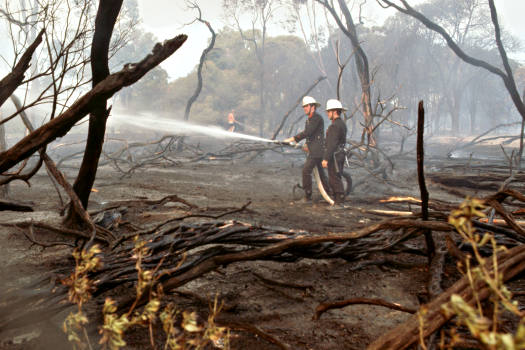
Fighting a fire at the Royal Melbourne Golf Links 1982. Courtesy Leader Collection.
The Melbourne summer that reached its height in January 1944 was hot and dry. In fact it remains the driest summer in Melbourne since records began in the mid-nineteenth century. In the summer months just 46 millimetres of rain fell, less than a third of the long-term average, as drought conditions gripped much of southern Australia leaving many areas tinder dry and fire-prone. The early weeks of 1944 produced heat wave temperatures and the second week of that year ended with century readings on the old Fahrenheit scale as north winds added to the furnace-like atmosphere. The year was just twelve days old when fires surrounded Beechworth and Wangaratta threatening lives and property, but a worse situation soon developed over much of the State. On Friday 14th January there began a two-day series of infernos in widely separated parts of Victoria as bushfires raged in country areas that included Daylesford, Woodend, Gisborne and other central Victorian towns near Bendigo. To the west of Melbourne there were blazes out of control from Geelong to the South Australian border. Fires burned near towns such as Hamilton, Skipton, Dunkeld, Birregurra, Goroke and Geelong itself. Many smaller towns were all but destroyed and 20 people lost their lives, many caught trying to flee from approaching fires and becoming disoriented in thick smoke before being overcome by severe heat and flames. That weekend it seemed that as one fire was controlled there would be a report of a new blaze at another location. Nearly every district in Victoria was affected including the Mornington Peninsula. In the beach suburbs of Beaumaris and Mentone the fire threat came swiftly and ruined the lives of many residents who were wrenched from their homes in the face of life-threatening danger.
That Friday Melburnians woke to a most uncomfortable day with the north wind beginning to blow and the expected century temperature already within reach. Later it went over 103 degrees F (about 40 degrees C). The strong northerly made it feel hotter than this and local firemen were on full alert. Just after 10 a.m. Mentone Fire Brigade received a call from Billy Ross in Milan Street where the veteran racehorse trainer had discovered a fire in his stables. Mentone firemen raced from their station on the corner of Mentone Parade and Brindisi Street and soon had the blaze under control, saving Ross’s dwelling from damage. As this action was proceeding further calls alerted them to a dangerous fire in Beaumaris where they headed with great speed while officers at Mentone Fire Station alerted other local brigades, beginning with the one at Cheltenham.
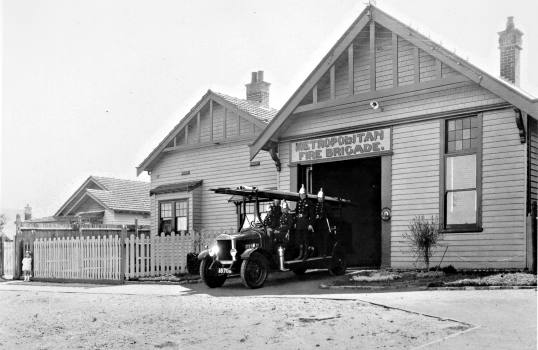
Cheltenham Fire Brigade. Courtesy Kevin Wilson.
In fact two separate fires appear to have affected the Beaumaris area, both beginning about 11 a.m. that day. These were the destructive ones that destroyed many homes. Earlier that day a smaller fire along Reserve Road near Victoria Golf links had burned scrub but had been controlled before it damaged houses. The first of the more serious fires broke out north of Balcombe Road and swept through the area near Perry Brothers’ Circus (close to the current Seaview shops) extending also towards the Reserve Road vicinity. At the time this part of Beaumaris was covered with ti tree scrub interspersed with other native trees and only a few dwellings were hidden away in what was almost a wilderness. The fire, fanned by the hot northerly, raged through the scrub at great speed devastating most of the area east of Reserve Road. It proceeded south until it reached Beach Road and the foreshore where it jumped the bitumen and burned the coastal ti tree. It was reported that another fire began near the Dillons’ property in Bonanza Road not far from the Beach Road-Charman Road corner. That section of the inferno also headed south and burned properties along Beach Road towards the Beaumaris Hotel. Several times it threatened the large hotel building but firefighters kept it at bay. It burned houses on both sides of the hotel and eventually reached the foreshore near Table Rock. The Beaumaris population was not large at this time but there were quite a few homes in the area behind the hotel in the Tramway Parade area where the fire damage was at its worst. This part of the fire also destroyed several large, modern Beach Road homes that had been built along that picturesque coast during the latter part of the thirties. Whether this part of the fire was caused by ‘spotting’ from the more central blaze, or whether it began separately, is not known. During the afternoon other localised blazes, caused by flying cinders, flared up and burned sections missed by the earlier fires.
Firefighters that day were suddenly faced with an impossible task and control of the operations was handed to Melbourne’s Chief Fire Officer, Kemp, when the extent of the disaster became obvious. Large numbers of volunteers, ARP wardens, army personnel and regular firemen fought the fires. Army trucks brought dozens of troops from barracks at Caulfield to bolster the reserves, and police from many stations attended as well. Despite their best efforts the fire could not be controlled and it really burned itself out when it reached the extent of the scrubland at the coast near Rickett’s Point. There were, of course, many cases where individual houses were saved by the efforts of fire fighters who were on the spot when the blaze reached a certain area. But there were just as many cases where the fire itself jumped some dwellings only to burn adjacent buildings in the most fortuitous way. Fire brigade officers reported that the water pressure was so bad that their hoses were useless, the flow being little more than a trickle even when pumps were used. This was confirmed recently by Brother Finian Allman, now in his mid-eighties. In 1944 he was a young De La Salle Brother working at St Bede’s College in Mentone where he still resides. That January about twenty Brothers were resident at St Bede’s during the school holidays and when the smoke pall appeared over at Beaumaris they rang the Beaumaris Hotel and offered their assistance. Their call was welcomed by the hotel manager so about fifteen of the younger Brothers put on old clothes and set out along Beach Road towards the area beyond the cliffs covered in shrouds of black smoke. The college had no car at that time, nor were any others in the area, so they literally ran to Beaumaris. Here they entered a terrifying scene. Brother Finian recalls meeting a man who was battling flames around his home in Tramway Parade. Finian and one of his confreres accompanied the owner into his house in an attempt to salvage property, only to be driven out by the blazing heat and then being forced to lie flat in the middle of the road with flames burning bush and buildings on either side of them. One timber house exploded into flames before their eyes. The young Brother admits to saying a silent prayer at that time as he feared for his life. He also remembers the firemen using expletives about the water pressure and the hopeless task of battling the blaze with old sacks for beaters. Finian and the other Brothers from St Bede’s were just a few among the scores of volunteers who would have told similar stories about the heat, the smoke and the frightening situations they faced during that day.
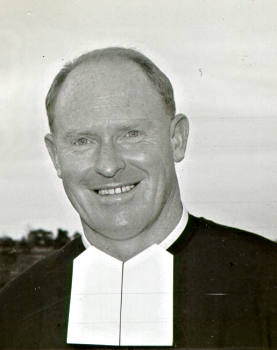
Brother Finian.
There was a problem of access to the fire front. Beaumaris at the time was rural in appearance as most of its streets were sandy tracks with trees overhanging what passed for roadways. Not only did this make it hard to get vehicles into the area but it added fuel for the fire, both overhead and on the ground where dead leaves accumulated, increasing the intensity of the blaze. Firemen were on duty through that weekend, almost continuously. There were few reserves; many men were away at the war. Laurie Brown, Mentone’s chief fireman, spent over two days on duty with his small staff because on the Saturday following the Beaumaris blaze a fire broke out in Heatherton north of the current Kingston Centre and burned large areas of Braeside until it reached the Lower Dandenong Road area. Brown’s Mentone Brigade fought that fire as well, finishing late on Sunday when they took care of smouldering hot spots.
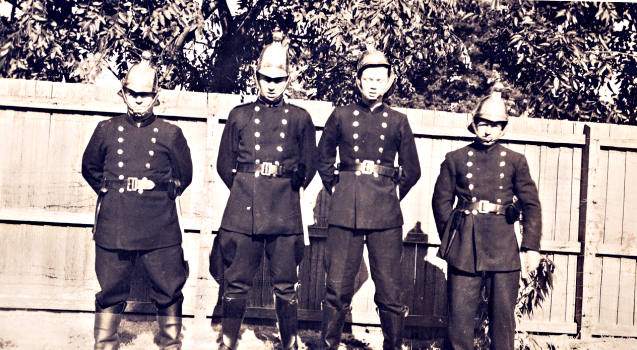
Mentone Firemen, c1940. Wal Davies, Laurie Brown, Len Bennison Jr, and John Kerr. Courtesy Margaret Milne.
People who lived in Beaumaris and close by experienced a terrifying Friday. From late morning the suburb was enveloped in thick black smoke, making it hazardous to move around and causing a frightening dark atmosphere which stifled normal breathing. Fire fighters faced this monstrous problem as well and it prevented them reaching any particular location with certainty. Curiously, as described by the Standard News reporters who ventured along Beach Road in a car, there were patches of bright sunshine adjacent to areas where visibility was virtually zero. Faced with the speed of the fire’s approach Beaumaris residents had to run for their lives. In a period when war had taken many men from their homes, and on a weekday when other men were at work, most of those fleeing the blaze were women and children. In most cases they took with them only the few belongings they could carry. Some people tried to save furniture and other goods by moving them into the street, or on to the front lawn, but in several instances this did not help because the fire burned the piles of possessions as it swept through. There were sad examples of motor cars burned where they stood in house driveways because there had been no time, or no one available, to move them out of harm’s way. On Beach Road near Rickett’s Point the Cliff Fern Caravan Park was badly affected when vans were burned before they could be removed.
When the conflagration finally subsided late on that Friday afternoon because no more scrub was left to burn, the scene was one of devastation and tragedy. At Rickett’s Point one reporter described the beach scene as resembling a large evacuation camp. Here were gathered scores of people, mostly women and children, many of them weeping openly as they contemplated the lost homes and possessions, rudely taken away from them in a few frantic hours. Mothers had experienced the terrifying fear earlier that day when they tried to ensure all their children were accounted for, a worrying situation when kids, enjoying the school holidays, were playing at neighbours’ homes or had gone down to the beach for a swim.
At the height of the fire threat, around the middle of the day, panic spread from Beaumaris to the fringes of Mentone, along Charman Road. Jill Goodes, who was a small child at the time, lived in Charman Road and remembers returning with her mother from a shopping trip in Mentone to the sight of towering columns of black smoke. Jill, with her mother, rushed to their home and found that her brother had packed all his toys into a dolls’ pram ready to leave. Like many others they did leave and ended up on Mentone beach. Here Jill remembers the fire burning through the scrub on the cliffs and blazing vegetation falling into the sea. Some dead stingrays were observed floating in the shallow water, apparently the victims of the burning trees hitting the water with a resultant sizzling in the sea.
Some of those at the beach that afternoon had piled goods into small boats that were moored near the beach, presumably to keep them safe. In one extraordinary incident a boat loaded with suitcases broke loose and drifted out to sea, driven by the strong northerly. It was recovered the next day at a point near Williamstown where the goods were collected and returned to their owner, Flight Lieutenant Parker. People also gathered on Mentone beach and more than a hundred spent the night camped on beaches there and around the Beaumaris area. Pet dogs, cats and birds in cages accompanied many residents to the beach refuge where they made up a veritable menagerie of domestic animals.
As always when tragic events overtake a community there occur stories of human kindness and care for others, but inevitably a few dishonourable acts take place as well. On that fateful Friday Beaumaris received the services of many willing helpers at the fire front, but away from the burning property and the smoked-filled scrubland the Red Cross and the Salvation Army moved among the victims gathered forlornly on the beaches. An army mobile canteen was brought in. Here refreshments in the form of tea, cool drinks and food were handed out, and later items of donated clothing helped those who had little except the light garments they wore when the fire forced them to run. Mrs Leary, who ran a milk bar on the Charman Road-Beach Road corner, threw open her shop for victims and fire fighters alike, offering a small haven on the edge of the battleground. People came together in support of one another that day and there would be a huge appeal campaign later on. Not everyone was altruistic. Police constables had to be posted in the Beaumaris streets that night because many items, saved from households, lay in the open near burnt-out homes and several people were later charged with looting materials from places that had been deserted by residents made homeless that day.
Throughout the Beaumaris–Black Rock district more than fifty homes were completely destroyed and when those that suffered serious damage were added the number reached close to one hundred. During the weekend after the blaze large numbers of sightseers visited the area and walked among the ruins of private homes. They observed the chimneys that stood starkly amongst the ashes, and saw what was left of household utensils twisted into unusable piles of strangely shaped junk. Some pots lay on stoves in melted down forms. Burned and singed vegetation was all that remained of gardens and lawns. The Standard News made biting comments about the sightseers, claiming that the crowd would have been no larger if the Melbourne Cup were being staged there. The paper claimed that people were in the way and that extra police had to be employed to control the traffic and keep looters out of properties.
It was said at the time that it was a miracle no lives were lost at Beaumaris. This seems a fair assessment considering the speed with which the fire raged through the scrub and there were stories of people just getting out in time, some reluctantly leaving homes they wanted to protect. One of these was May Robertson who police removed from her Beach Road home minutes before it went up in flames. Mrs Robertson was a high profile resident, having been the first female to sit on Mordialloc Council in the early 1930s when she fought hard for facilities in her area. She was a prominent member of the West Ward movement, a group that at one time wanted the residents of the Charman Road area to secede from Mordialloc and join Sandringham where they thought they would be better treated. In the streets close to Mrs Robertson’s burnt home, namely Wells Rd and Bonanza Rd, homes belonging to residents called Finlay, Fleming, Coates, Laird, Hitchcock and another Robertson were among those destroyed.
It seems that Tramway Parade was the worst of all Beaumaris streets affected by the fire. Along that winding route of the old horse tram twenty homes were listed as destroyed, while eight more were lost along Dalgetty Road. Cromer Road, Coreen Avenue, Hardinge, Rennison and Stayner Streets also figured among the locations of burnt-out dwellings. During that weekend of confusion wild rumours spread about the extent of losses but it would be months before the true cost of the disaster could be assessed. Initial estimates in many tens of thousands of pounds were quoted but they are meaningless in today’s figures. Adjusted for inflation the losses in current dollar values would be in tens of millions, perhaps more than one hundred million. Apart from the loss of dwellings the fire cut telephone and electricity lines as the timber poles burned and fell in many streets.
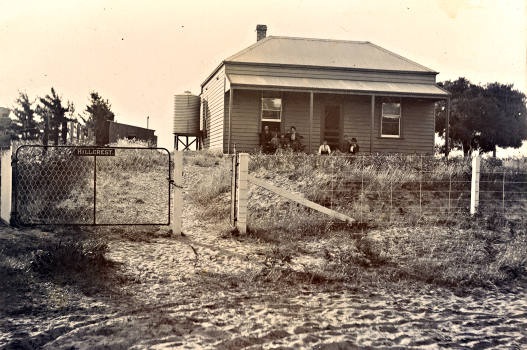
Residence at 35 Cromer Road in 1912. Destroyed in the 1944 fire. Courtesy Ron Walker.
The disaster at Beaumaris produced a wide and generous local response but there was also a State and Federal acknowledgment that help for fire victims was desperately needed, because fire had ravaged many parts of south-eastern Australia. The Prime Minister, John Curtin, announced an immediate £200,000 Commonwealth grant for fire victims in NSW and Victoria, while the Victorian Premier, Albert Dunstan, added a State grant of £50,000*. Public appeals were opened in local areas including the bayside suburbs. Co-ordinated by local councils they raised many hundreds of pounds. In the first week the Mordialloc Carnival Committee donated £250 from its holiday funfair takings and the private donations flowed in from far and wide. On Saturday, 15th January, the day after the fires, Mentone Racing Club staged its regular metropolitan race day on its course near Lower Dandenong Road. The races were held, despite the shock of the fire tragedies, and one can be sure that racing people contributed to the appeals for fire victims, as at that time Mentone and Mordialloc housed dozens of racing stables with their associated trainers, jockeys and strappers. It was ironic that the first race on the Mentone card that Saturday was the ‘Beaumaris Handicap’ which was won by Port O’Call, ridden by the now-legendary Scobie Breasley.
The aftermath of the Beaumaris fires also produced much finger-pointing and attempts to attribute blame, as always happens when major fires occur in Australia. The Mordialloc News immediately went on the attack. As part of Standard News Company it was a vehicle for the views of its editor-manager, E.J. Trait, who was then at the height of his career in local newspapers and always willing to offer provocative opinions. Trait’s paper ran the headline, BLACK FRIDAY ON BAYSIDE, and proceeded to analyse the fire disaster. While offering generous praise for the firemen and all the other volunteers, including the Red Cross and the Salvation Army, Trait wrote scathing comments about Beaumaris residents and, by implication, the local authorities. Part of his report said:
Friday’s intense heat, with a blistering northerly, brought to a head a fire hazard that has existed in Beaumaris for years. Whilst councils allow private residents to thwart their efforts to make private streets in that area on the pretext that the beauties of nature must not be interfered with this menace will always exist. Many homes in Beaumaris are in “streets” which are simply lanes—and lanes which are not even clean lanes, littered as they are with dry leaves, dead branches of trees and black sand. Even if some people prefer to live midst “nature” in surroundings of that kind, their wishes should not be gratified, because of the danger to surrounding homes in decent streets.
Trait went on to appeal for Mordialloc and Sandringham Councils to insist on street construction. He also pointed out that in Oak Street, one of Beaumaris’s few properly made streets, there had been little damage to homes as scrub had been cleared away from the buildings.
In the days following the fires there was intense interest in Beaumaris. The Governor of Victoria, Sir Winston Dugan, with Lady Dugan, visited the scene. Lady Dugan, as president of the Red Cross, promised that she would try to get more help from that society. The mayors of the two affected municipalities made visits to the disaster area as well, while the press published continuing accounts about the appeals for fire victims and the names of donors. As the months went by the scrub began to regenerate and life returned to normal, though some residents never returned to their ruined Beaumaris properties to live. In a period of wartime building restrictions and shortages of materials, the stark spectres of chimneys standing alone in ruined and flattened homes were visible for years before new houses could replace them. In the late forties and through the 1950s a building boom transformed the suburb into a more densely populated place, adding many bitumen streets along the way. Much of the ti tree scrub was retained but the fire risk was reduced and no fire of the 1944 proportions has ever struck again.
The 1944 fires produced a turning point in community thinking about such disasters. Initially, as people looked for reasons for such fires, there was much talk about gas producers on cars. These were large blackened devices attached to the back of vehicles and, in a period of wartime rationing when each motorist was limited to a few gallons of petrol a month, they offered a partial solution to private transport restrictions. A gas producer worked by using combustible charcoal to emit flammable gas that would power an automobile. Just as, currently, a number of cars run on gas, the forties saw a proportion of motorists convert their cars to this option. It was not surprising that this happened considering the fact that many Australians drove large American cars that did only about fifteen miles to the gallon. (15 miles is about 24 km and one gallon is about four and a half litres) The petrol ration coupons were soon used up on any trip out of the neighbourhood. Gas producers helped supplement petrol rations but they were also blamed for dropping burning embers of charcoal and causing fires, so at the time of the Beaumaris blaze there was talk of banning them. After the war ended in 1945 and petrol rationing eased, gas producers disappeared into history’s curiosity list where they caused no more fires.
In the 1940s the widespread controls that now exist over aspects of backyard behaviour did not apply. For instance, nearly all houses had backyard incinerators and residents lit them when they felt a need to burn rubbish. Bonfires in vacant paddocks were part of the culture and many people attended them at least once a year, on Guy Fawkes Night, 5th November. People burned off dry grass and leaves without any control over when it was safe to do so, and, though most residents were careful, it took only one act of negligence to start a dangerous fire in areas where bushland was close to settlements. No one knows what caused many of the 1944 fires but it is safe to say that careless ‘burning off’ was involved in some of them. Days of total fire ban, proclaimed by fire authorities for a whole State, or a district within it, were in the future. It was not until the CFA and MFB received specific powers in the late 1950s that centrally-determined regulations about lighting fires in certain areas on certain days were applied.
It was the 1944 fires that finally brought action on the co-ordination of fire fighting on a State-wide basis. In the disastrous fires of both 1939 and 1944 it had been found that efficient management of fire fighting groups had been lacking. For instance, there was no central control over when the burning of fire breaks was safe, no central body exerted control over bush brigades throughout the State of Victoria, and warning systems were not really adequate. No central direction of fire-fighting resources was in place, so that it was possible for brigades to be available for action but not called to the areas of most need in a crisis situation when confusion could occur at times. There had been a Royal Commission on fire services after the 1939 bushfires but no action had occurred during the war. After the 1944 fires, and the inefficient responses to them, there was immediate government action on fire control outside the city boundaries. In 1945 the Country Fire Authority was established as the co-ordinating body for brigades beyond the jurisdiction of the Metropolitan Fire Brigade. This body is still operative after nearly sixty years and, with its city counterpart, determines fire bans on fire-danger days.
The fires at Beaumaris provided an example of the dangers that occur when outer metropolitan housing development reaches into pristine bush. Australian cities have continually faced this problem on their fringes. In 1983 the Ash Wednesday disaster provided another spectacular instance in the Dandenongs near Melbourne, and the outskirts of Sydney and Canberra have had shocking infernos over very recent summers. The interface between the city and the bush in Australia has often provided the venue for terrifying fire events. Beaumaris in 1944 was one in a long series.
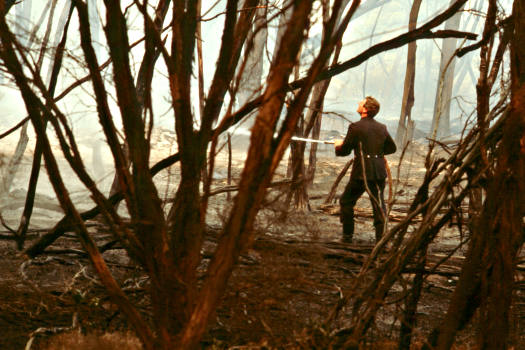
Fire at the Royal Melbourne Golf Club 1982. Courtesy Leader Collection.
